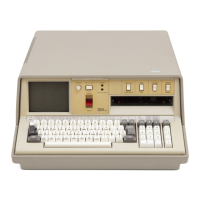(
If
(
(
GO [Iine-num]
[,
{~~ENp
}]
LRO=n]
TRACE
LPRINT]
GO
COMMAND
You can use the GO command
to
do
the
following:
1. Resume processing
of
a
MAR
K command operation
that
was halted.
2.
3.
Resume processing of a BASIC program
that
was halted by:
a. a PAUSE statement,
b.
executing statements in step mode (see
RUN
Command),
c. some error conditions,
or
d. your pressing
the
ATTN key.
End a MARK command operation or BASIC program before it reaches its
normal termination point.
You can resume processing by pressing EXECUTE on a blank line. The
GO
command,
however, allows you
to
resume processing
in
any
of
three modes
of
operation (normal,
step,
or
trace). Thus, you can change
the
operating mode with
the
GO command.
Program execution can be continued with
the
next sequential
statement
or
at
a
statement
number specified in
the
GO command. You can also change
the
decimal
position
that
activates rounding (see RD= Command).
To
terminate
the
execution
of
a system command or a BASIC program,
the
GO
command has this syntax:
GO
END
END closes input and
output
files,
thus
maintaining
the
integrity of
the
files. After
the
files are closed, no program statements are executed.
To
continue execution
of
an interrupted operation,
the
GO
command
has this syntax:
GO [line-num]
[,
{~~E~
}]
LRO=n]
TRACE
LPRINT]
where:
line-num
is
the
number of
the
statement
at
which processing
is
to
be resumed.
If
this number
is
omitted,
processing begins with
the
next
sequential
statement
or where
the
command
was interrupted.
11

